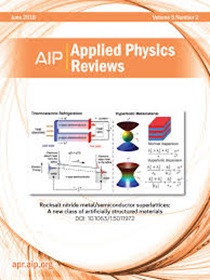CoxC催化剂的结构、性能及在费托反应中的应用
IF 11.9
1区 物理与天体物理
Q1 PHYSICS, APPLIED
引用次数: 0
摘要
经典的费托制烯烃反应(FTO)是将合成气转化为低烯烃的关键方法,合成气来源于化石能源,如煤、生物质和天然气。对FTO扩展或商业化日益增长的兴趣推动了具有卓越性能的催化剂的发展。低烯烃(C2-4 =)广泛用作日常产品的基本成分,如洗涤剂、润滑剂、塑料、药品和化妆品添加剂。此外,具有官能团C -的高级醇不仅可以提高催化反应中的原子利用率,而且还可以作为可燃物、燃料或燃料添加剂以及各种精细化学品的原料。近年来,新型过渡金属碳化物催化剂在FTO催化反应的探索和应用中备受关注。本文系统地综述了用于高效利用COx (x = 1,2)的非贵金属碳化钴CoxC (x = 2,3)催化剂的研究进展。综述了CoxC基催化剂在形成过程中的相变、性质、活性、产物选择性以及这些因素之间的相互关系。最后,讨论了目前coc基催化剂在FTO中有效利用COx所面临的挑战,以及对未来潜在商业应用的展望。本文章由计算机程序翻译,如有差异,请以英文原文为准。
Structure, properties, and applications of CoxC catalysts for Fischer–Tropsch reaction mechanism and perspective
The classical Fischer–Tropsch to Olefins (FTO) reaction is a pivotal method for converting syngas, derived from fossil energy sources, such as coal, biomass, and natural gas, into lower olefins. The growing interest in expanding or commercializing FTO has driven the development of catalysts with exceptional performance. Lower olefins (C2–4=) are widely used as fundamental components in everyday products such as detergents, lubricants, plastic, pharmaceuticals, and cosmetic additives. Additionally, higher alcohols with functional C– groups can not only improve the atomic utilization in catalytic reactions but also serve as raw materials for combustibles, fuels or fuel additives, and various fine chemicals. In recent years, new transition metal carbide catalysts have attracted significant attention in the exploration and application of FTO catalytic reactions. This paper systematically reviews the research progress of non-noble metal cobalt carbide CoxC (x = 2, 3) catalysts for the efficient utilization of COx (x = 1, 2). The review covers the phase transitions during the formation of CoxC-based catalysts, their properties, activity, product selectivity, and interrelationships among these factors. Finally, the current challenges facing CoxC-based catalysts in effectively harnessing COx in FTO are discussed, along with perspectives on potential future commercial applications.
求助全文
通过发布文献求助,成功后即可免费获取论文全文。
去求助
来源期刊

Applied physics reviews
PHYSICS, APPLIED-
CiteScore
22.50
自引率
2.00%
发文量
113
审稿时长
2 months
期刊介绍:
Applied Physics Reviews (APR) is a journal featuring articles on critical topics in experimental or theoretical research in applied physics and applications of physics to other scientific and engineering branches. The publication includes two main types of articles:
Original Research: These articles report on high-quality, novel research studies that are of significant interest to the applied physics community.
Reviews: Review articles in APR can either be authoritative and comprehensive assessments of established areas of applied physics or short, timely reviews of recent advances in established fields or emerging areas of applied physics.
 求助内容:
求助内容: 应助结果提醒方式:
应助结果提醒方式:


